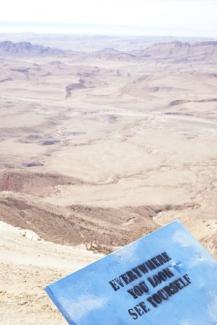ALI in the Middle East_May 2014

June 27, 2014
ALI co-directors Hadley and Peter Arnold traveled to Israel, Jordan and Palestine in May to explore exchange possibilites with the Arava Institute, an environmental peace-building program that brings students together from across the Middle East. The trip was designed to introduce ALI to the water-energy challenges and opportunities facing the region, and identify points of possible collaboration. Students and faculty interested in finding out more are invited to drop us a line.
Against a backdrop of profound mistrust, violent conflict, and militarized landscapes, Arava students, professors, alumni, and NGO partners work to build stable, collaborative cross-border projects with shared management of natural resources. Projects led by Dr. Clive Lipchin of Arava's Center for Transboundary Water Management include urban greywater installations in Beit Sahour, Palestine, designed to alleviate septic contamination of local aquifers; smallscale biogas reactors in unrecognized Bedouin villages in Wadi Aricha; and the early stages of transboundary stream restoration, where widely divergent contamination standards and enforcement practices undermine water systems shared by multiple cultures.
In the Negev desert, ethonbotanist Elaine Solawey has identified and propagated water-effiicient, salt-tolerant, nutrient-dense, soil-building cash crops in the desert at Kibbutz Ketura for 40 years. Her most renowned project: successfully germinating Methusaleh, a 2,000-year-old date palm seed uncovered in excavations at Masada. We saw strong possibilties for applying and testing her botanical research in salt-crusted environments in California such as the dry Owens Valley Lakebed.
In Jordan, hydrologist Dr. Samer Talozi introduced us to the condition of the Jordan River as it reaches the Dead Sea. With surface water overallocated between Syria, Palestine, Jordan, and Israel, the river consists principally of agricultural run-off, industrial effluent, and wastewater, some treated, some not, by the time it reaches its outlet. Dr. Talozi outlined challenges to groundwater posed by Syrian refugee camps; the limitations of Jordan's first national water carrier, opened in 2013 and found to contain naturally occurring radioactive contamination shortly thereafter; and the most recent version of the Red Sea-to-Dead Sea proposal. With potable water restricted to weekly deliveries, the rationale for desalination is a strong one. The proposed desal plant would produce fresh water delivered to Israel in the south in exchange for surface water transfers to Jordan from the Galilee in the north. The impacts of brine on the Red Sea maritime environment; the cost of the energy-intensive desalination process on an energy-poor nation (Jordan imports 97% of its energy); and a collaborative management framework remain challenges.
In search of ingenuity built into historical and vernacular landscapes, we peeled off from contemporary water projects to take a look at the archeological water systems of Jarash, the best-preserved Roman city in the Levant; the carved sluices of Nabatean Petra, its redrock landscape moulded to carry, bank, and celebrate desert stormwater; and the masssive lift of desert water to Herod's mesa-top palace at Masada, complete with temple-scaled cisterns, palace moats, and infinity pools 1,000 feet above the hyper-arid desert floor. We explored Jerusalem's ancient water supply before heading north to trace Israel's national carrier and water-recycling system up the (over-allocated, effluent-contaminated, barbed-wire-bounded) Jordan River to the Sea of Galillee. Crossing to the 11-km aqueduct at Caesarea and back to Tel Aviv, our meeting with Ofir Ben Tov, aerial photographer of desert landscapes, was a revelation and, we hope, the beginning of a great friendship.
We thank our hosts and guides, Amit Chertoff and Sarah Rubin; our Arava colleagues Clive Lipchin and David Lehrer; and our co-travellers and fellow teachers, anthropologist Dr. Jonathan Golden of Drew University's Center on Culture, Religion, and Conflict; environmental lawyers Peter Reich and Karen Schapiro; biologist Susan Jenkins; and Walter Reed Middle School Traveling Scholar Josie Harriet Arnold.
With the escalation in conflict, our thoughts are with our peace-building friends and colleagues, Jordanian, Israeli, and Palestinian. With the complexity, heartache, and richness of the region fully in mind, we continue to explore how ALI's geospatial research capabilities might make a contribution to the critically important work of transboundary water management in the region. We invite interested students and researchers to get in touch.
Recent posts
February 15, 2018
February 12, 2018
February 12, 2018
Archives
- July 2020 (1)
- February 2018 (4)
- August 2016 (1)
- July 2016 (3)
- April 2016 (1)

